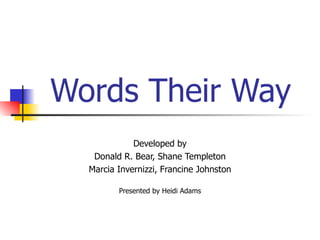
Word Study Method Explained for Improving Reading and Spelling
- 1. Words Their Way Developed by Donald R. Bear, Shane Templeton Marcia Invernizzi, Francine Johnston Presented by Heidi Adams
- 2. What is Word Study? Method for examining words Active process Students categorize words and pictures Students learn about words which improves their reading and writing
- 3. Layers of Information in English Spelling 1. Alphabetic – letters describe sounds left-to-right 2. Pattern – groupings of letters representing sounds 3. Meaning – letter groups can directly represent meaning
- 4. Stages of Spelling 1. Preliterate 2. Early Letter Name 3. Middle and Late Letter Name 4. Within Word Pattern 5. Syllable Juncture 6. Derivational Constancy
- 5. Preliterate Spelling Corresponds to emergent reading Scribble, letter-like forms Spelling ranges from random marks to legitimate letters without sound-symbol correspondence
- 6. Early Letter Name Spelling Corresponds to learning predictable pattern books and rhymes, beginning readers Apply alphabetic principal primarily with consonants Often omit vowels
- 7. Middle and Late Letter Name Spelling Corresponds to reading disfluently, word-by-word, and inexpressively Focus on regular vowels, initial consonant blends and digraphs
- 8. Within Word Pattern Spelling Corresponds to phrasal reading fluency Experimentation with long vowel patterns
- 9. Syllable Juncture Spelling Corresponds to automatic word recognition Use of affixes Correct initial and final consonants
- 10. Sequence of Study at Syllable Juncture Stage 1. Plural endings 2. Compound words 3. Open and closed syllables: simple inflectional endings 4. Homophones 5. Open and closed syllables: VCCV and VCV patterns 6. Changing final y to i 7. Accent 8. Spelling pattern for /cher/ sound, / r/ sound, and the / l/ sound at the end of words 9. Simple prefixes and base words
- 11. Derivational Constancy Spelling Also corresponds to automatic word recognition Use of specialized vocabulary of Greek and Latin origins
- 12. Sequence of Study at Derivational Constancy Stage 1. Spelling/Meaning Connection 1. Consonant Alternations Silent/sounded /t/ to /sh/ /k/ to /sh/ 2. Vowel Alternation Patterns 1. Long to short 2. Long to schwa 3. Schwa to short 2. Greek and Latin Word Elements 1. Greek Prefixes 2. Greek roots 3. Latin roots
- 13. Sequence of Study at Derivational Constancy Stage (continued) 3. Predictable Spelling Changes: Consonants and Vowels t/c d/s Long to short Long to schwa 4. Absorbed or “Assimilated” Prefixes
- 14. Implementation 1. Assess current level 2. Determine groups 3. Set up schedule 4. Develop a weekly routine
- 15. Assessing Current Level 1. Collect a spelling sample Daily writing Spelling inventory Analyze sample Monitor growth Plan instruction
- 16. Determine Groups Base on level 3 groups recommended Circle work with teacher Seat work Center work
- 17. Schedule Time for small group work Short directed lessons Time to sort independently and with partners Include activities to recognize, recall, judge, and apply targeted concept
- 18. Recognize Present particular feature Guide through word comparison Generate a word list and post
- 19. Recall Recall examples of feature Word Hunt
- 20. Word Hunts Bridge between word study and students’ reading and writing Hunt through reading and writing for words that are examples of the featured pattern
- 21. Judge Look through words for those that match studied feature Word hunt in familiar readings Closed sort
- 22. Word Sorts Closed Sorts Teacher defined categories Guided Gradual student control Independent practice Open Sorts Student defined categories of known words
- 23. Word Sorts (continued) Blind Sorts Teacher determines categories Teacher or student calls out words Students determine which category Writing Sorts Teacher determines categories Teacher calls out words Student writes words in appropriate category Speed Sorts For speed Use only when accuracy is guaranteed
- 24. Apply Apply learned skill to create something new Open sort Word Hunt Games
- 25. Games Card games Rummy Memory Board games Stressbusters Jeopardy
- 26. Weekly Routine Example Monday – introduce sort Tuesday – practice sort and write it Wednesday – blind sorts and writing sorts Thursday – word hunts or games Friday - assessment
- 27. Assessment Traditional spelling test Spellingcity.com Include definitions for derivational relations spellers
- 28. Ten Principles of Word Study Instruction 1. Look for what students use but confuse. 2. A step backward is a step forward 3. Use words students can read 4. Compare words “that do” with words “that don’t.” 5. Sort by sight AND sound
- 29. Ten Principles of Word Study Instruction (continued) 6. Begin with obvious contrasts first 7. Don’t hide exceptions. 8. Avoid rules. 9. Work for automaticity. 10. Return to meaningful texts.
- 30. One Golden Rule Teaching is not telling.
- 31. Sources Words Their Way: Word Study for Phonics, Vocabulary, and Spelling Instruction Word Sorts for Derivational Relations Spellers
- 32. Questions ?
Notas del editor
- 3. ed, s, ing 7. Contract 8. lecture, puncture, 8. winter, motor, lunar 8. able, cancel
- 1.1.1 sign/signal 1.1.2. connect/connection 1.1.3. music/musician 1.2.1 please/pleasant 1.2.2. compete/competition 1.2.3 locality/local
- 3.1 silent/silence 3.2 explode/explosion 3.3 vain/vanity 3.4 explain/explanation 4. In + mobile = immobile
- 1.2 example
- 2. Build scaffold 3. From any source 4. Contrasts are essential
- 6. m/s – not m/n 7. Put irregular words into misc category 8. “patterns” instead 9. Move from hesitancy to fluency
- Teachers “stack the deck,” but allow students to discover.
